

Rob-n-Hild Take the High Road!
Click links to jump to specific days:
Start | Nerdy
| Stranger Things
| Stairs Stairs Stairs
|
|||||||||||||||||||||||||||||||||||||||||||||||||||||||||||||||
|
Unst Island Today Hild drove 96.5 km. Cumulative driving: 1055.7 km, Hild 559.5, Rob 496.2 Hermaness Hike Distance 10.37 km in 5:22 hours. Walking time 2:25 hours. |
|||||||||||||||||||||||||||||||||||||||||||||||||||||||||||||||
| The main reason for visiting Unst Island was to hike in Hermaness National Nature Reserve. We caught the first ferry of the day from Gutcher (Yell) to Belmont (Unst). We had aimed for the second ferry, but when we arrived on the quay, the previous one hadn't left yet, and they reopened the gate just for us. How embarrassing! However, the ferry was empty apart from us, so maybe they were just lonely. | |||||||||||||||||||||||||||||||||||||||||||||||||||||||||||||||
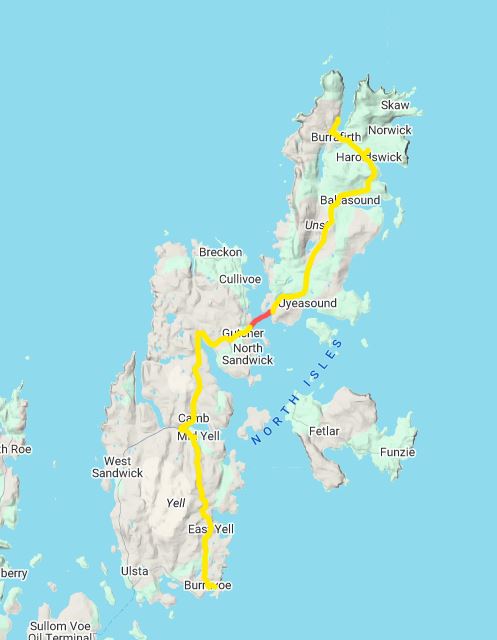
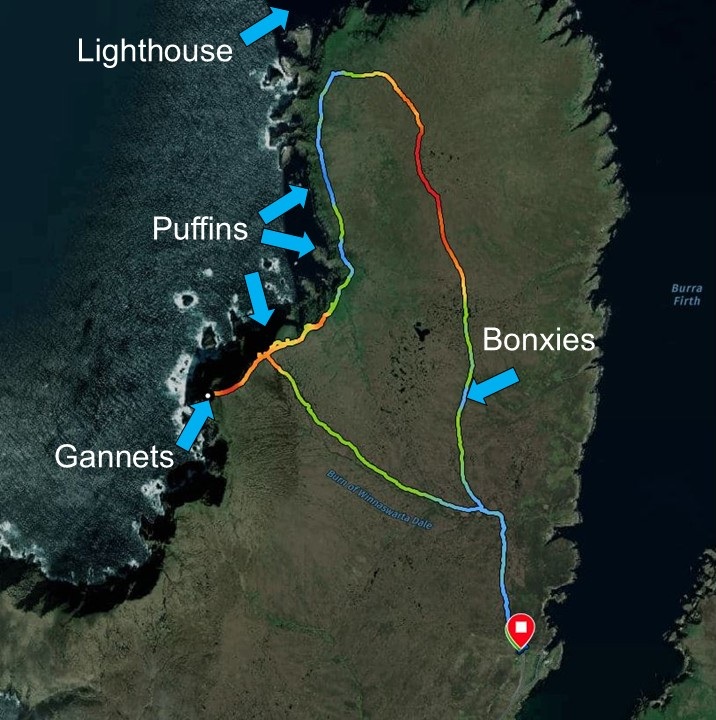
|
|||||||||||||||||||||||||||||||||||||||||||||||||||||||||||||||
| We are learning quickly to drive on single-lane roads with passing places when one meets oncoming cars. There are also cattle grids everywhere and sheep and lambs to avoid. It is much like driving from Stavanger to Valle in Norway, although the roads here are narrower. The quality of the roads are good though. No potholes! As Rob says: Never mind the width - feel the quality of roads on Shetland (not like the British television sitcom 1967-1971: "Never mind the quality - feel the width") | |||||||||||||||||||||||||||||||||||||||||||||||||||||||||||||||
| After a short drive to the north end of the island, we found a nice car park at the entry to the Reserve. Clearly some people in camper vans had stayed overnight. We were happy to find space for Percy and to discover that they have public toilets. All good things. | |||||||||||||||||||||||||||||||||||||||||||||||||||||||||||||||
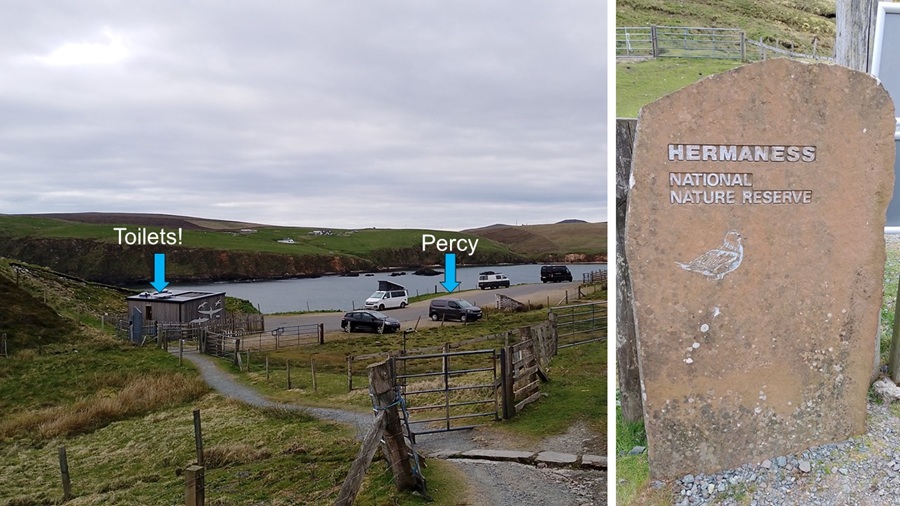
|
|||||||||||||||||||||||||||||||||||||||||||||||||||||||||||||||
| The circular hike around Hermaness includes gravel tracks, boardwalks, and slogging across bogs. We chose to wear wellies, but since there has been very little rain lately, we could have been OK in hiking boots. | |||||||||||||||||||||||||||||||||||||||||||||||||||||||||||||||

|
|||||||||||||||||||||||||||||||||||||||||||||||||||||||||||||||
|
First a shout-out to Adelheid and Hege who are part of a project to
eradicate or at least battle ferns ("ormegras" in Norwegian)
on Hege's property. You should be happy that you are not responsible
for this area - lots of ferns EVERYWHERE!!
About 30 crofters graze 1,000 sheep (total) on Hermaness Reserve. Every year they collaborate to bring all sheep to their crofts for lambing. This is called "to caa the sheep off the hill". Sounds like the Norwegian "saueleiting"! The rest of the year these hardy sheep manage on their own on the hill. For generations the hills have been used for grazing and for peat used as fuel. Then there was a bit of excitement: We hadn't ventured far onto the hill before Hild heard a sheep baaaa followed by a very faint lamb baaaa. Just over the next hill she spotted the head of a small lamb sticking out of the bog. The sheep are not very tame, and the mother started running away when we got close. The lamb was too small to get out of the soggy mud but grabbing it by the scruff of its neck and pulling brought it out. Hild tried to squeeze as much of water and mud off its wool as possible, but she had to release the lamb before mum disappeared. The lamb's legs were a bit shaky at first, but we watched them for a while, and it soon got to feed off its mum. Hopefully we saved a little lamb from a chilly death. Of course, now Hild was soggy wet too. Luckily her trousers and base layer dried off relatively quickly in the strong wind. |
|||||||||||||||||||||||||||||||||||||||||||||||||||||||||||||||

|
|||||||||||||||||||||||||||||||||||||||||||||||||||||||||||||||
| At the far end of our hike, standing on cliffs 150 metres up, we could view the home of 100,000 sea birds. From Neap we could see everyday life (and smell the guano) at the huge gannet colony. | |||||||||||||||||||||||||||||||||||||||||||||||||||||||||||||||
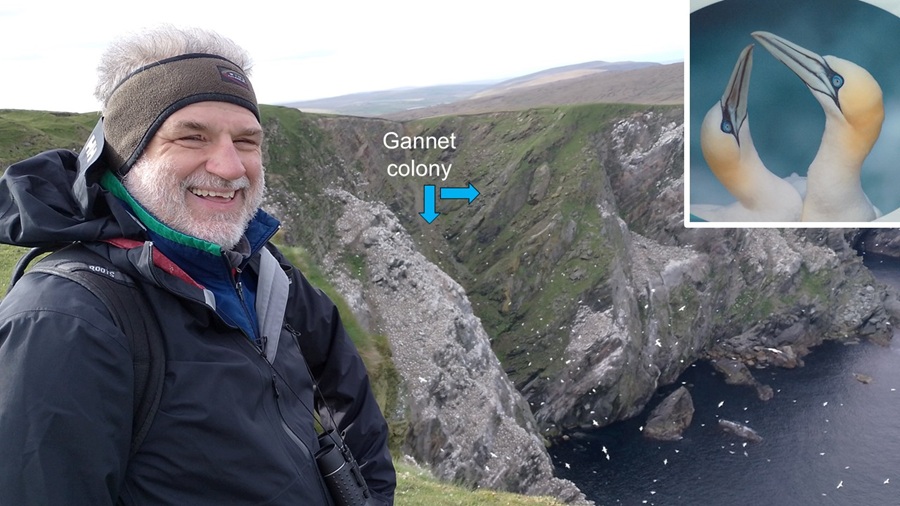
|
|||||||||||||||||||||||||||||||||||||||||||||||||||||||||||||||
| The strong and quite cold wind meant we needed several water breaks. One of them involved Kvikk Lunsj (Norwegian version of Kit Kat). | |||||||||||||||||||||||||||||||||||||||||||||||||||||||||||||||
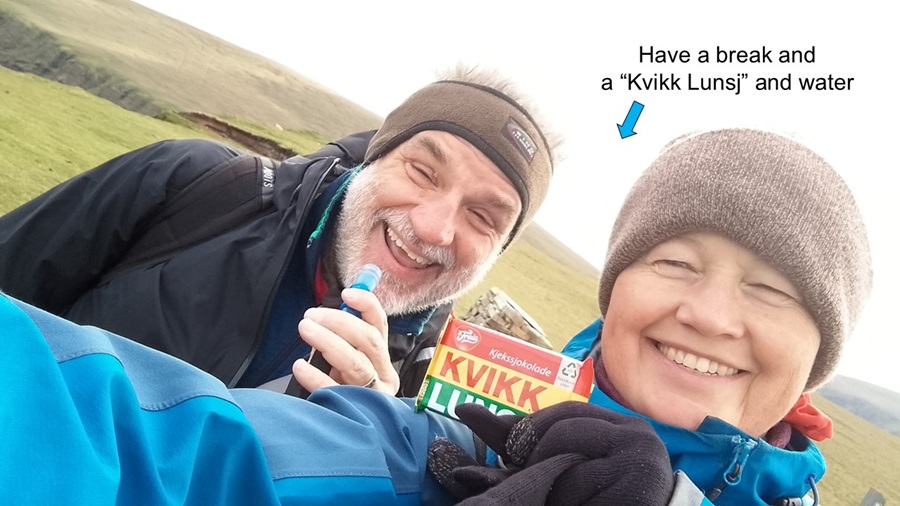
|
|||||||||||||||||||||||||||||||||||||||||||||||||||||||||||||||
| In several spots we sat down with binoculars to spot different birds. Of course we wanted to see puffins most of all. Apart from the fun of spotting birds, the cliffs are very impressive and dramatic to look at too. | |||||||||||||||||||||||||||||||||||||||||||||||||||||||||||||||

|
|||||||||||||||||||||||||||||||||||||||||||||||||||||||||||||||
| In this spot there were signs keeping us away from unstable cliffs, but we could still spot the puffins from a safe distance. | |||||||||||||||||||||||||||||||||||||||||||||||||||||||||||||||
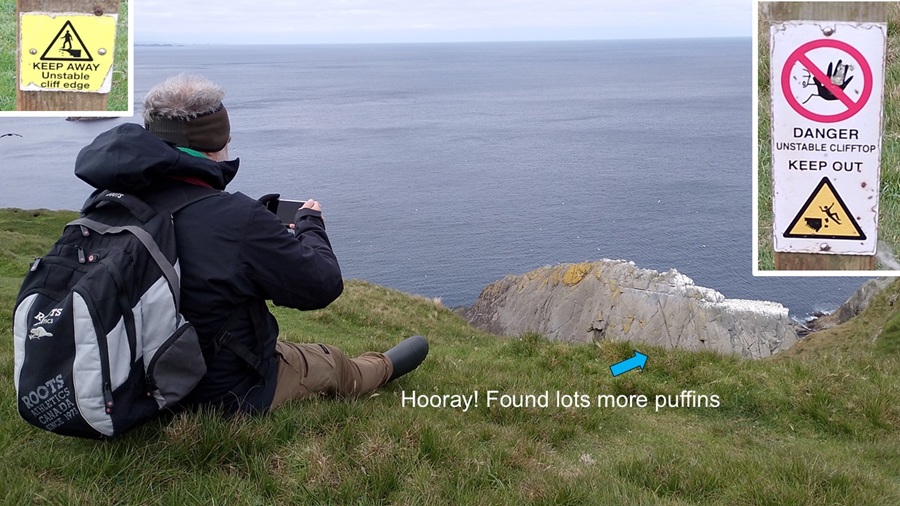
|
|||||||||||||||||||||||||||||||||||||||||||||||||||||||||||||||
|
At this time of the year they are quite busy sitting on their
eggs, but we were lucky to spot them flying around and then
landing gracefully and crawling into their burrows. We learnt
to spot them in the crowd of thousands of other birds because puffins
are very black, and they flap their wings very fast. Other birds
were soaring almost without flapping wings.
We don't have professional cameras to take photos of birds, so our blurry photos don't do the puffins (or any bird) justice. Their beaks are so colourful at this time of year, and their legs are bright orange. |
|||||||||||||||||||||||||||||||||||||||||||||||||||||||||||||||
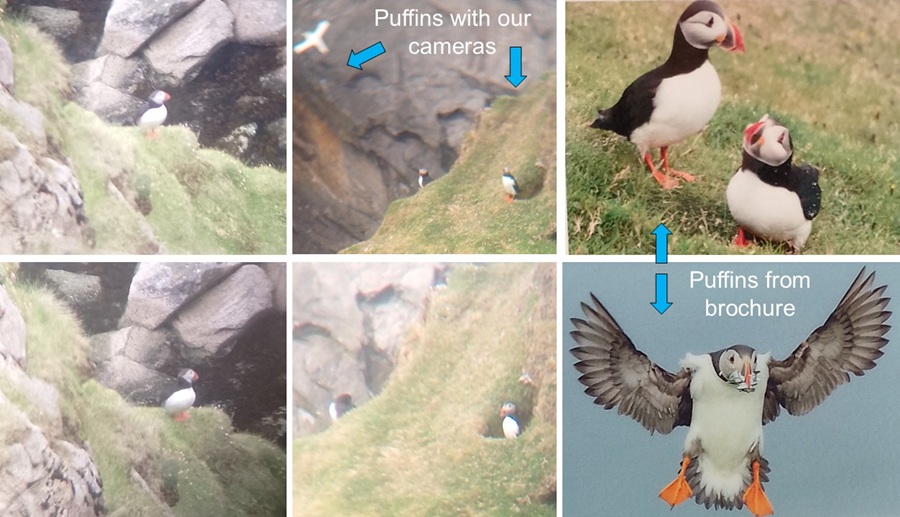
|
|||||||||||||||||||||||||||||||||||||||||||||||||||||||||||||||
| Tammy, our Newfoundland mascot (Shetland word for Puffin is Tammie Noorie), was excited to meet her cousins here in the UK. The Minions were not entirely sure if this was safe... | |||||||||||||||||||||||||||||||||||||||||||||||||||||||||||||||
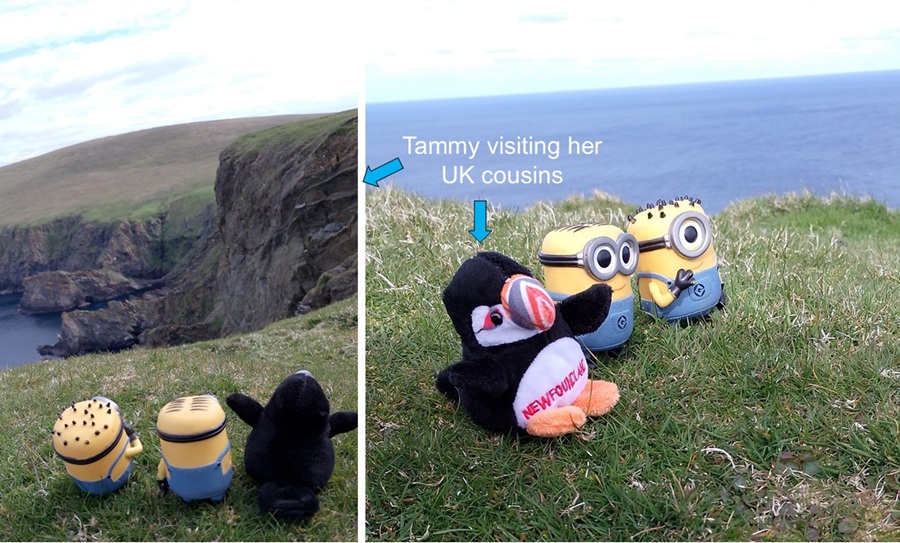
|
|||||||||||||||||||||||||||||||||||||||||||||||||||||||||||||||
|
There were several gannet colonies along our route.
We noticed how sea birds like the gannets and fulmars soar
in the air - away from the cliffs, out across the sea, and back
to the cliffs. Every time we thought they would land, but again
and again they gave up and turned out to sea again.
Having seen how good the puffins are at landing; we can only conclude that the other sea birds are good at flying/soaring but not very good at landing. Puffins are the best! |
|||||||||||||||||||||||||||||||||||||||||||||||||||||||||||||||
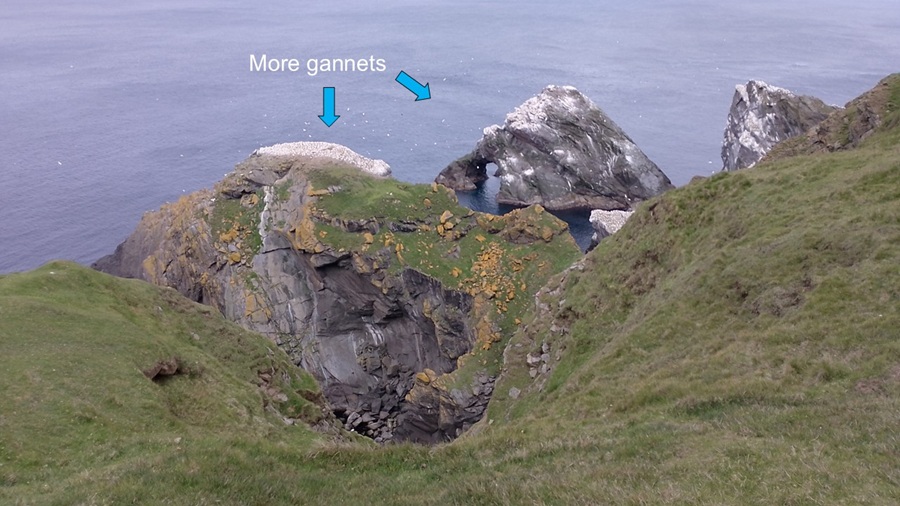
|
|||||||||||||||||||||||||||||||||||||||||||||||||||||||||||||||
| Before turning back across Hermaness Hill, we got a big view of Muckle Flugga lighthouse, 1.6 km offshore and 60 metres above sea level. Waves frequently reach the lighthouse. Beyond the lighthouse we spotted Out Stack - the most northerly part of Britain. | |||||||||||||||||||||||||||||||||||||||||||||||||||||||||||||||
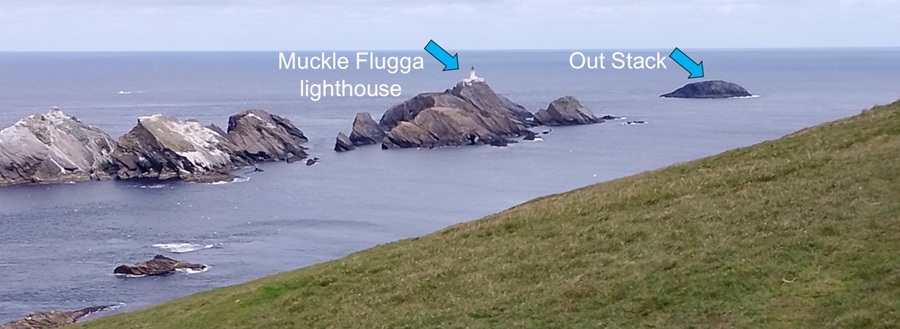
|
|||||||||||||||||||||||||||||||||||||||||||||||||||||||||||||||
|
On our return across Hermaness Hill we sometimes had to walk through
the soggy bog. In the soggiest areas they had installed boardwalks, thankfully.
Posters at the start of the park warned us about Bonxies (Great Skua). They nest on the moorland and get annoyed with hikers walking past. The Bonxies we met were not very annoyed and didn't dive-bomb us - as we had been warned. about. They circled us, keeping a close eye on us until we left. |
|||||||||||||||||||||||||||||||||||||||||||||||||||||||||||||||
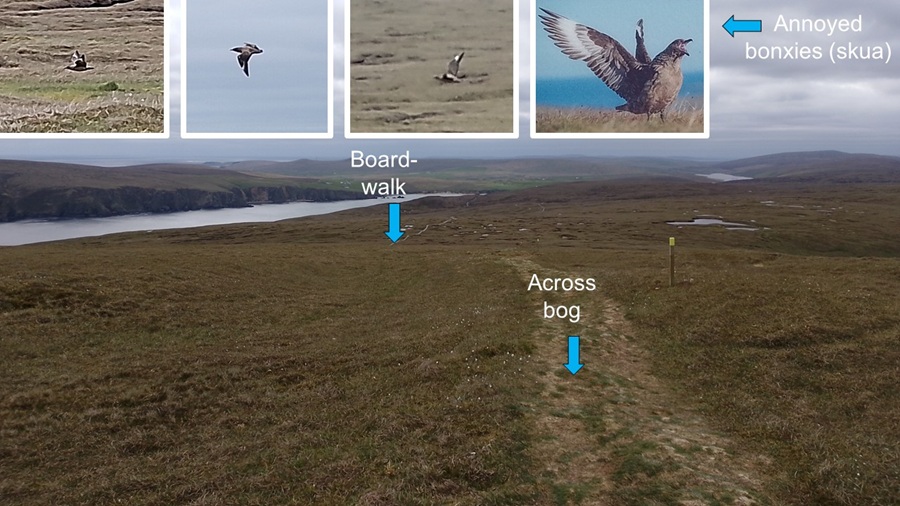
|
|||||||||||||||||||||||||||||||||||||||||||||||||||||||||||||||
|
Our hike was coming to an end, and Rob was skipping happily down the stair.
How energetic!
After returning to the car park, we had lunch in Percy before heading off to explore more of Unst. |
|||||||||||||||||||||||||||||||||||||||||||||||||||||||||||||||
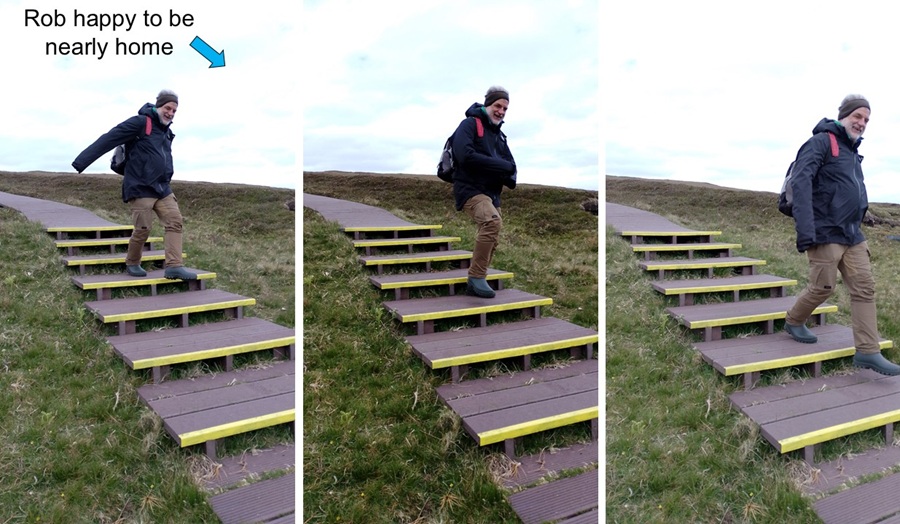
|
|||||||||||||||||||||||||||||||||||||||||||||||||||||||||||||||
| We stopped by Unst Heritage Centre. There were many interesting displays about everything from local geology to history (two world wars), agriculture, fishery, and making it clear that it has been hard to make a living here. | |||||||||||||||||||||||||||||||||||||||||||||||||||||||||||||||
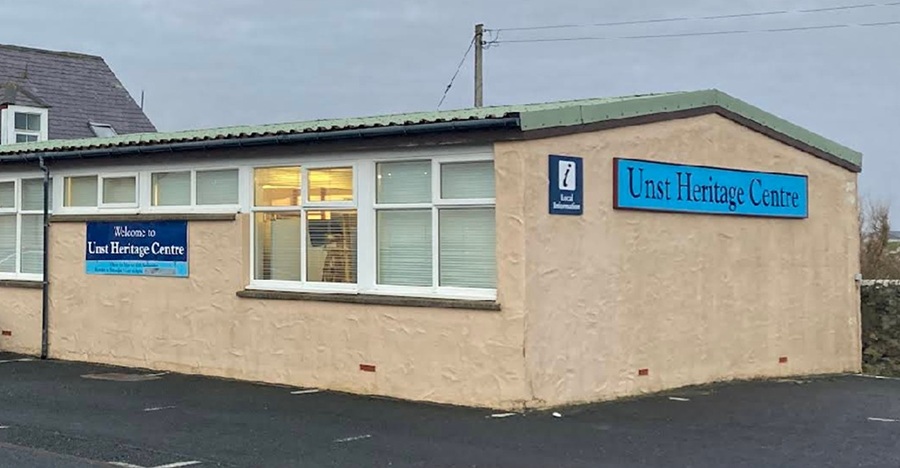
|
|||||||||||||||||||||||||||||||||||||||||||||||||||||||||||||||
|
We spent an hour and a half walking around reading the information.
One of the displays of an old bedroom showed old fashioned hot water bottles,
and all we could think of was frequent leakages with just simple corks
in a stoneware bottle!
Then there was a cute baby bed that could grow with the baby! |
|||||||||||||||||||||||||||||||||||||||||||||||||||||||||||||||
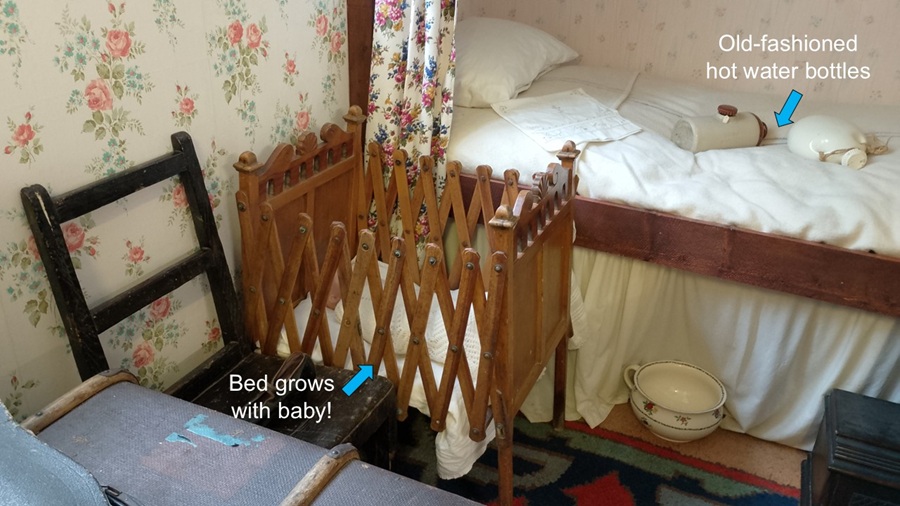
|
|||||||||||||||||||||||||||||||||||||||||||||||||||||||||||||||
|
We had a good chat with the woman at the reception. Lynn is also a crofter
and was happy to hear that we may have saved a lamb on the moor. We told her
that the sheep and lamb were marked with blue spray paint. Hild's hand was
still bright blue from the earlier interaction. Her sheep were coloured
green, and we had met some of those too. Three of the lambs playing together
caught our eyes earlier because they were clearly triplets, and we
seem to only see one lamb per sheep elsewhere. The owner said she was
also surprised to receive three lambs. The mother has enough milk for
all three of them - so they won't be "tåtelam" (bottle fed) like we
would often do in Norway.
The display below shows how many different sheep fleeces there are, and how many different colours they get to make knitwear from. |
|||||||||||||||||||||||||||||||||||||||||||||||||||||||||||||||
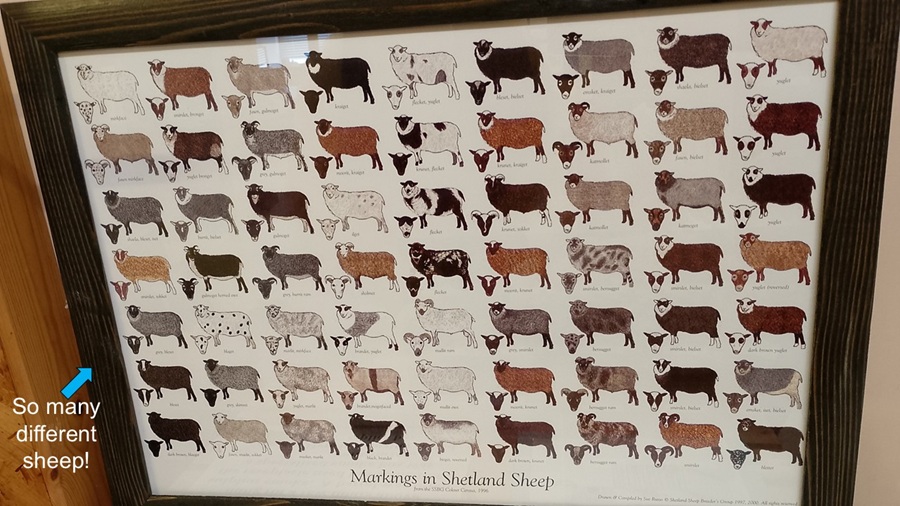
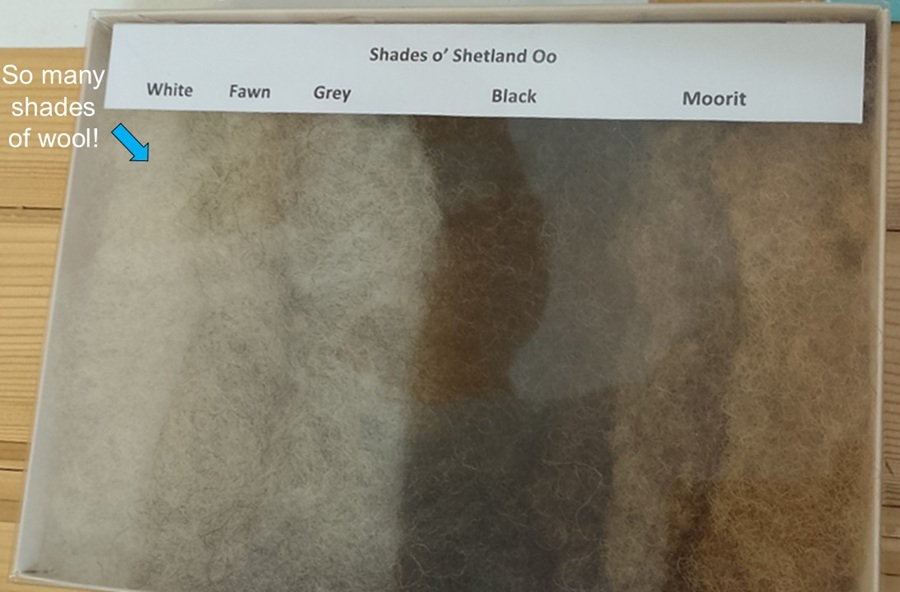
|
|||||||||||||||||||||||||||||||||||||||||||||||||||||||||||||||
|
We left the heritage centre when it was filled by a bus load of
Swedish ladies who had come to learn how to knit Shetland-style.
Instead we drove a few minutes down the road to visit a Viking longhouse and longship. The longhouse looks a lot like the Norwegian ones, except ours are made from wood and these are made out of stone - because they have stones and not trees... |
|||||||||||||||||||||||||||||||||||||||||||||||||||||||||||||||

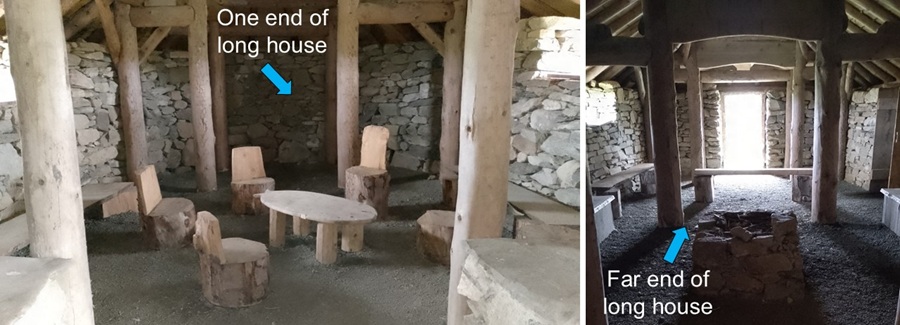
|
|||||||||||||||||||||||||||||||||||||||||||||||||||||||||||||||
|
This longship is called the Skibladner. It is a full-scale replica of the 9th
century Gokstad ship found in Sandefjord in Norway in 1880. This replica was
supposed to have sailed from Sweden to America, but had to give up in Shetland.
The original Skiblader - from Norse mythology - was a ship made by the dwarfs and they gave it to the god Freyr. It was said to be large enough to carry all the gods, yet may be taken to pieces, and carried in a purse. Hmmmm, that’ll be some purse! Maybe this is where JK Rowling came up with the idea for Hermione’s magic purse in the Harry Potter books? |
|||||||||||||||||||||||||||||||||||||||||||||||||||||||||||||||
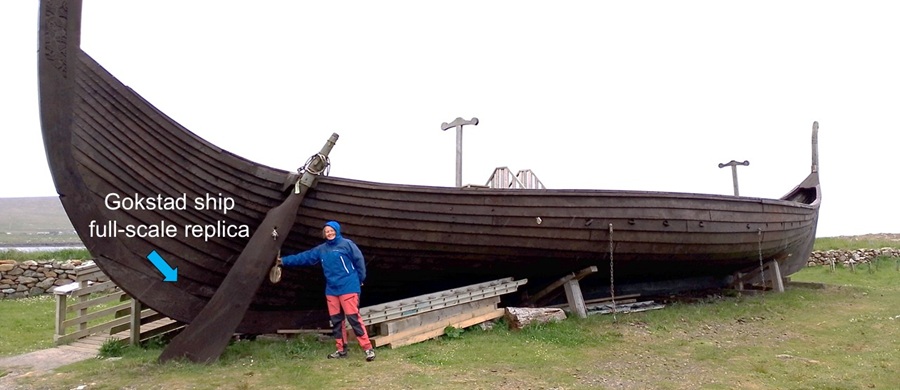
|
|||||||||||||||||||||||||||||||||||||||||||||||||||||||||||||||
| The tiller had been carved with a dragon head on one end, and a small Viking holding on for dear life at the other end! Made us laugh and wonder if that was also found on the Gokstad ship... | |||||||||||||||||||||||||||||||||||||||||||||||||||||||||||||||
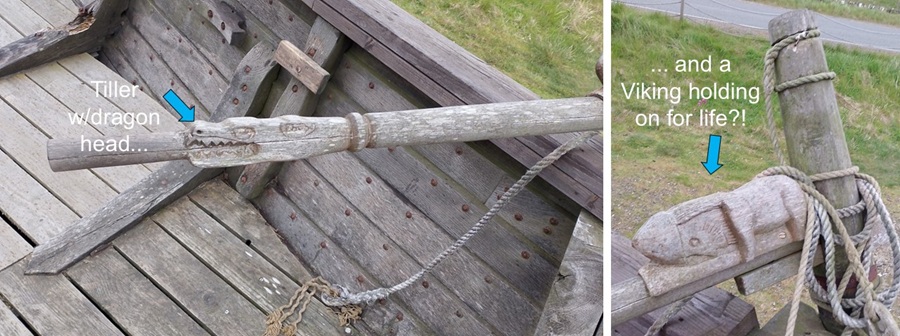
|
|||||||||||||||||||||||||||||||||||||||||||||||||||||||||||||||
| Another planned stop brought us to locally famous "Bobby's Bus Shelter". Don't know who Bobby is, but today the shelter had art on the walls, a comfy bench, carpet, a library, flowerpots, and painted rocks for decoration. Visiting Google Streetview and other travel blogs shows that the bus shelter changes contents every now and then. | |||||||||||||||||||||||||||||||||||||||||||||||||||||||||||||||
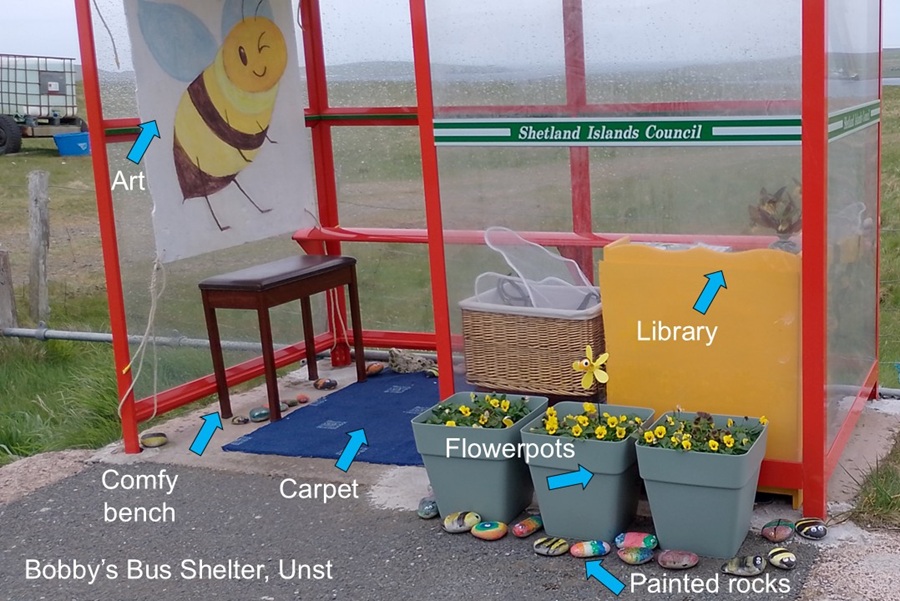
|
|||||||||||||||||||||||||||||||||||||||||||||||||||||||||||||||
| From the road we spotted this art installation shaped as a pyramid and made from buoys. It reminded us of an art installation we saw in Edmonton, Canada, a few years back: metal balls of different sizes stacked in a pyramid shape. It is called the Talus Dome. | |||||||||||||||||||||||||||||||||||||||||||||||||||||||||||||||
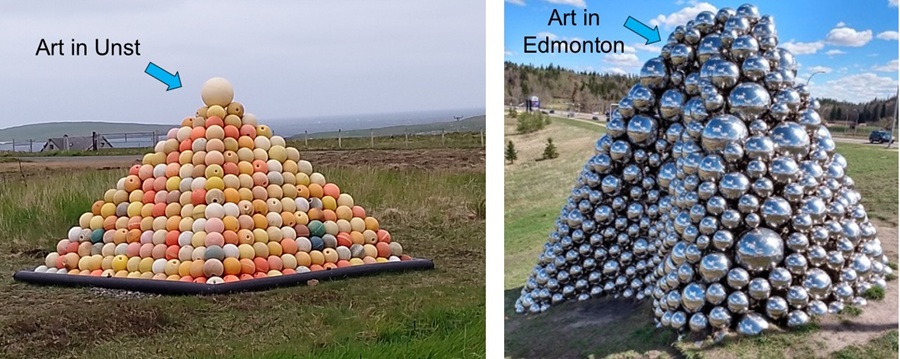
|
|||||||||||||||||||||||||||||||||||||||||||||||||||||||||||||||
| We caught Bigga the ferry back from Unst to Yell and back home to relax. It had been a long day. | |||||||||||||||||||||||||||||||||||||||||||||||||||||||||||||||
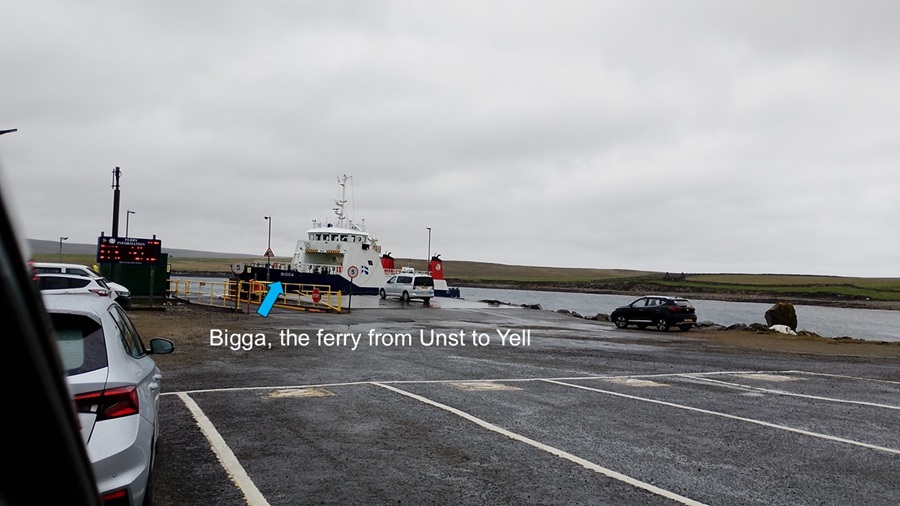
|
|||||||||||||||||||||||||||||||||||||||||||||||||||||||||||||||
| We treated ourselves to tomato soup with noodles for dinner followed by pancakes and strawberry yoghurt for afters. Then we converted the mobile office into a big screen movie theatre and watched several episodes of Buffy the Vampire Slayer. A perfect end to a perfect day. | |||||||||||||||||||||||||||||||||||||||||||||||||||||||||||||||
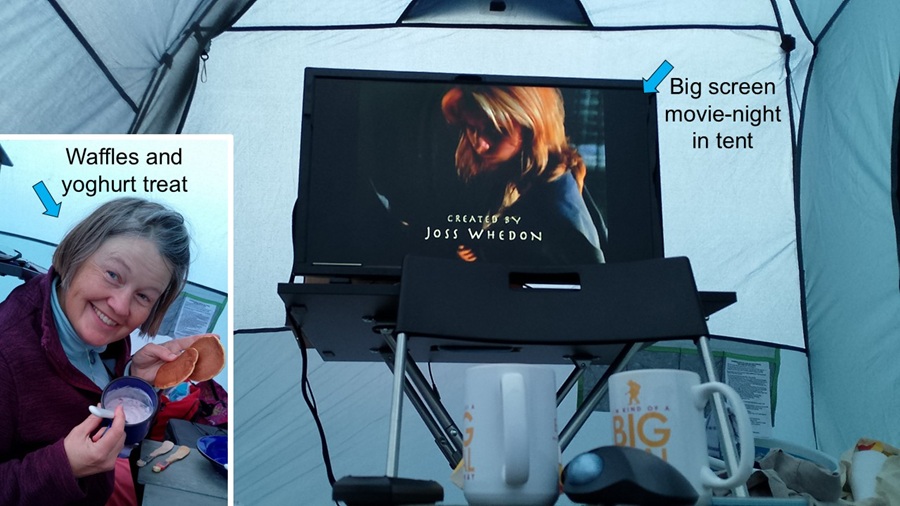
|
|||||||||||||||||||||||||||||||||||||||||||||||||||||||||||||||
| Coming up: Off to Scalloway | |||||||||||||||||||||||||||||||||||||||||||||||||||||||||||||||
Start
| To Previous Day
| To Next Day
| Nerdy
| Stranger Things
| Stairs Stairs Stairs
May-July 2025
May-July 2025

